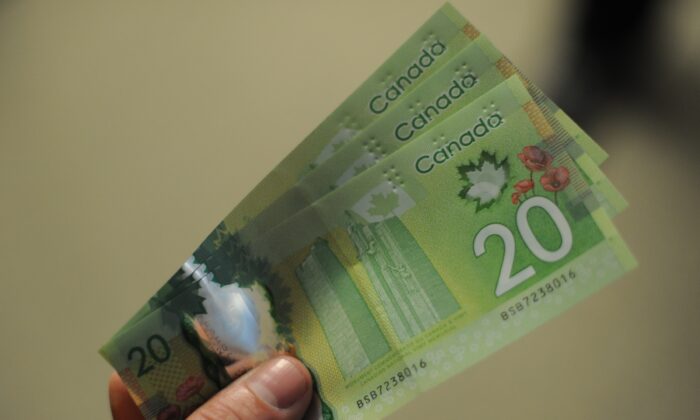
A man displays Canadian 20-dollar bills in a file photo. (Nicholas Kamm/AFP via Getty Images)
By
Canadians are tired of “tip-flation” and “tip creep” and would rather employers pay servers higher wages so that tipping will no longer be necessary, a new Angus Reid poll finds.
In the online survey, 62 percent of Canadians said they are being asked to tip more, and 64 percent said they’re being asked to tip more often. Respondents also said places that didn’t used to request a tip before are now requesting it, according to the survey conducted from Jan. 31 to Feb. 2.
“Inflation is a spectre haunting all aspects of Canadian life as the country emerges from the expansionary monetary policy of the early days of the COVID-19 pandemic. It has touched food, housing, and even common customary practices like tipping,” the survey report said.
The days of the 15 percent standard tip are gone, it noted, as “tip-flation” has point-of-sales machines now suggesting tips as high as 30 percent.
Over half of respondents, 59 percent, said they would prefer a “service included” model, which would end tipping in favour of higher employee base wages. This contrasts with 2016 survey results, which found only 40 percent preferred this model. Moreover, in 2016, 46 percent of respondents preferred having tipping as part of the experience, whereas that figure dropped to 32 percent in the 2023 survey.
“This represents a significant shift in public opinion on tipping,” said Angus Reid.
Restaurants might be reluctant to move to a new system, however. The report gave the example that, if restaurants raised prices by 20 percent to increase employee wages, they would be taxed on the additional revenue.
Most of those polled, 78 percent, said gratuities are no longer about showing appreciation for a job well-done, and 73 percent said tips are letting employers underpay staff.
“Notably, in Canada, there is a two-tiered minimum wage system only in Quebec which allows businesses to pay those earning tips at their jobs lower than others. Other provinces have eliminated such minimum wage differences in recent years,” said the report.
Of the 1,610 adults surveyed, 86 percent of those in favour of ending gratuities also felt the current system is letting employers underpay employees. Of those in favour of continuing gratuities, only 53 percent agreed.
With respect to tipping amounts, Canadians are reporting tipping more than they were in 2016. One in five polled (21 percent) said they left a gratuity of 20 percent or more on their last full-service restaurant visit, more than double the 8 percent of individuals who said so in 2016.
On the lower end of the scale, 23 percent of respondents said they left a gratuity of 14 percent or less in this year’s poll, much lower than the 44 percent of those who said so in 2016.
‘Tip Creep’
“Canadians also report ‘tip creep’—where locations that previously may not have prompted for a tip have added the request to digital payment machines—as a source of fatigue,” noted the survey report.
It said that 83 percent of respondents said too many places are requesting tips, and that only 13 percent thought customer service has improved as gratuities have increased. Of those polled, 42 percent said they were going out to eat less due to the extra cost of tipping.
Another key finding is that those in British Columbia are the most likely to report “tip creep” (74 percent) and “tip-flation” (73 percent). Meanwhile, those in Atlantic Canada are the least likely to say they’re being prompted for a higher tip (42 percent).
The view on tipping also varied by political affiliation. Canadians who voted Conservative or Bloc Québécois in the 2021 federal election were more likely to prefer tipping. Of those who voted Liberal, 73 percent were in favour of a service included model, as were 76 percent of NDP voters.
Views on tipping also varied by industry. Most of those polled said bartenders (64 percent), barbers (60 percent), and food delivery drivers (58 percent) should receive a tip. Less than half of respondents said the same for other types of service providers, such as beauty salon personnel (47 percent), taxi or Uber driver (47 percent), and hotel housekeepers (42 percent).